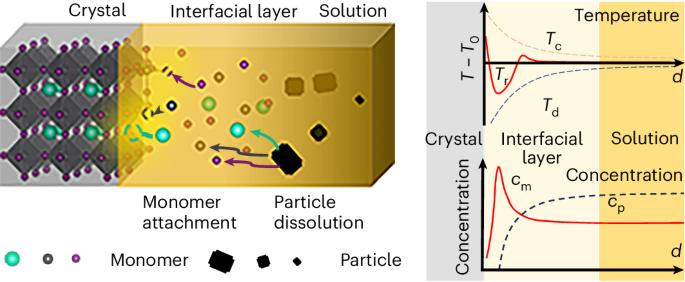Self-regulated facet stability during solution growth of perovskite crystals
IF 20
0 CHEMISTRY, MULTIDISCIPLINARY
引用次数: 0
Abstract
Solution growth of metal halide perovskites has enabled the development of applications including solar cells, light-emitting diodes and detectors, but the crystal growth mechanism remains unclear. Herein we studied the in situ transition of solute to crystals at the solid–liquid interface of methylammonium lead triiodide single crystals in γ-butyrolactone solution using microscopic spectroscopy. By establishing a temperature–bandgap relationship of the precursor solution, we observe a cooler interfacial region (1.5–4 μm from the crystal edge), explained by endothermic particle dissolution. This cooler region serves as a protective layer, hindering the attachment of particles with random orientations, maintaining the crystal facet orientation. The cooler interfacial protective layer is formed by the dissolution of particles driven by latent heat from crystallization and the concentration gradient of monomers at the interface. Disruption of the protective layer results in polycrystals with irregular facets. The understanding of the growth mechanisms of perovskite crystals provides insights for further improving the quality of solution-grown crystals. The in situ growth of methylammonium lead triiodide crystals in γ-butyrolactone is investigated. A cooler interfacial layer that serves as a protective layer to preserve the crystal facet orientation is observed.

钙钛矿晶体溶液生长过程中的自调节面稳定性
金属卤化物钙钛矿的溶液生长使太阳能电池、发光二极管和探测器等应用的发展成为可能,但晶体生长机制尚不清楚。本文采用显微光谱法研究了γ-丁内酯溶液中三碘化甲基铵铅单晶固液界面处溶质向晶体的原位转变。通过建立前驱体溶液的温度-带隙关系,我们观察到一个较冷的界面区域(距离晶体边缘1.5 ~ 4 μm),这是由吸热颗粒溶解引起的。这个较冷的区域起到了保护层的作用,阻止了随机取向的粒子的附着,保持了晶体面取向。较冷的界面保护层是由结晶潜热和界面单体浓度梯度驱动粒子溶解形成的。保护层的破坏导致具有不规则表面的多晶。对钙钛矿晶体生长机理的了解,为进一步提高溶液生长晶体的质量提供了思路。研究了三碘化甲基铵铅晶体在γ-丁内酯中的原位生长。观察到作为保护层以保持晶体面取向的较冷的界面层。
本文章由计算机程序翻译,如有差异,请以英文原文为准。
求助全文
约1分钟内获得全文
求助全文

 求助内容:
求助内容: 应助结果提醒方式:
应助结果提醒方式:


